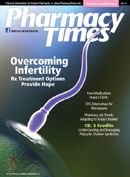Publication
Article
Pharmacy Times
Clinical Trials
DATA PRESENTED FROM 2 PHASE 3 TRIALS OF INVESTIGATIONAL COMBINATION ASTHMA DRUG
Researchers recently presented data from 2 phase 3 studies of the investigational fixed-dose combinations of mometasone furoate and formoterol fumarate (MF/F) in 2 poster presentations at the recent American Academy of Allergy, Asthma & Immunology annual meeting. The 2 studies assessed the safety and effectiveness of MF/F, which combines the active ingredients of an inhaled corticosteroid (ICS)— mometasone furoate inhalation powder (Asmanex Twisthaler)—and a long-acting beta2 agonist (LABA)—formoterol fumarate inhalation powder (Foradil Aerolizer), via a single metered-dose inhaler (MDI).
In the first randomized, multicenter, double-blind, placebo-controlled study, researchers investigated MF/F 100/10 mcg administered via an MDI twice daily in patients aged 12 years and older with persistent asthma previously treated with low-dose ICSs with or without a LABA; 746 patients were randomized to 26 weeks of doubleblind, twice-daily treatment with MF/F (100/10 mcg); mometasone furoate MDI (100 mcg), formoterol MDI (10 mcg), or placebo. Compared with formoterol, MF/F 100/10 mcg twice daily increased time to first severe exacerbation and decreased the proportion of patients experiencing severe exacerbations (44.7% of formoterol-treated patients vs 16.5% of MF/F-treated patients experienced severe exacerbations). In addition, compared with mometasone furoate, patients taking MF/F showed improvements in lung function (the mean forced expiratory volume in 1 second area under the concentrationtime curve over baseline was 4 literhours in MF/F-treated patients vs 2.53 liter-hours in mometasone furoate— treated patients).
The second study, a randomized, multicenter, double-blind, placebocontrolled clinical trial, assessed MF/F 200/10 mcg administered via MDI twice daily in patients aged 12 years and older with persistent asthma previously treated with medium-dose ICSs with or without a LABA; 781 patients were randomized to 26 weeks of doubleblind, twice-daily treatment with MF/F (200/10 mcg); mometasone furoate MDI (200 mcg), formoterol MDI (10 mcg), or placebo.
The researchers found that, compared with formoterol, MF/F 200/10 mcg twice daily increased time to first severe exacerbation and decreased the proportion of patients experiencing severe exacerbations (54% of formoterol- treated patients vs 30% of MF/Ftreated patients; P <.001). Compared with mometasone furoate, patients treated with MF/F 200/10 mcg twice daily showed improvements in lung function (1.30 liter-hours in patients treated with mometasone furoate vs 3.11 liter-hours in MF/F-treated patients; P <.001).
EVEROLIMUS EFFECTIVE IN TREATING STOMACH CANCER
Gastric cancer, commonly referred to as stomach cancer, is the fourth most common cancer worldwide and is the second leading cause of cancer death worldwide. The results of a phase 2 study recently published online in the March 15 Journal of Clinical Oncology showed that everolimus (Afinitor) is promising in treating this deadly cancer. This phase 2 study, which evaluated the safety and efficacy of everolimus in pretreated patients with advanced gastric cancer, included 53 patients and had one primary end point— disease control rate (DCR)—and 3 secondary end points—progression-free survival (PFS), overall survival (OS), and safety.
The researchers found a decrease in tumor size from baseline in 45% of patients by central review. In addition, the DCR was 56%. The median PFS was 2.7 months, and, at follow-up at 9.6 months, median OS was 10.1 months. Adverse events were consistent with the reported safety profile of the drug. Additional clinical trials, including a phase 3 study currently recruiting patients, are under way to evaluate the safety and efficacy of everolimus in advanced gastric cancer patients.
TREATMENT WITH TELEPRAVIR REGIMENS HOLDS PROMISE FOR HCV PATIENTS
Data from the PROVE3 trial, a randomized, stratified, partially placebo-controlled, partially double-blind phase 2 study involving 453 patients, showed that telepravir- based regimens are significantly more effective than the current standard of care in helping patients with chronic genotype 1 hepatitis C virus who failed previous therapy achieve a sustained virologic response (SVR; which means the virus remains undetectable in patients’ blood 6 months after they have finished treatment). For the study, patients were randomized to receive 1 of 4 treatment regimens, 3 of which contained telepravir, an investigational direct-acting antiviral.
The achievement of SVR was the study’s primary end point—this rate was significantly higher in each of the telepravir groups than with the control group (51%, 53%, and 24% in the telepravir treatment groups vs 14% in the control group). The complete study was published in the April 15 issue of the New England Journal of Medicine.
TASPOGLUTIDE MAY BRING NEW OPTIONS TO DIABETES PATIENTS
Taspoglutide, the first weekly human glucagon- like peptide-1 analog, has shown a positive effect on reducing blood glucose, according to data from the first 5 phase 3 trials of the drug. In the 5 trials, once-weekly taspoglutide met the primary end points of reduction in blood glucose and also led to “consistent weight loss, a minimal risk of hypoglycemia, and a manageable safety profile,” according to Roche.
The complete clinical trials program investigating taspoglutide, called T-emerge, includes 8 phase 3 trials enrolling more than 6000 patients. The trials include placebo-controlled and active comparator—controlled studies with current standards of diabetes care. Because taspoglutide met the primary end points in the first 5 phase 3 trials and was generally well-tolerated, the drug may improve treatment options for diabetes patients.







